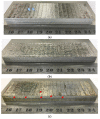Mechanical Properties of Titanium/Nano-Fluorapatite Parts Produced by Laser Powder Bed Fusion
- PMID: 36837132
- PMCID: PMC9964098
- DOI: 10.3390/ma16041502
Mechanical Properties of Titanium/Nano-Fluorapatite Parts Produced by Laser Powder Bed Fusion
Abstract
Laser powder bed fusion (L-PBF) has attracted great interest in recent years due to its ability to produce intricate parts beyond the capabilities of traditional manufacturing processes. L-PBF processed biomedical implants are usually made of commercial pure titanium (CP-Ti) or its alloys. However, both alloys are naturally bio-inert, and thus reduce the formation of apatite as implants are put into the human body. Accordingly, in an attempt to improve the bioactivity of the materials used for making orthopedic implants, the present study decomposed fluorapatite material (FA, (Ca10(PO4)6F2)) into the form of nano-powder and mixed this powder with CP-Ti powder in two different ratios (99%Ti + 1%FA (Ti-1%FA) and 98%Ti + 2%FA (Ti-2%FA)) to form powder material for the L-PBF process. Experimental trials were conducted to establish the optimal processing conditions (i.e., laser power, scanning speed and hatching space) of the L-PBF process for the two powder mixtures and the original CP-Ti powder with no FA addition. The optimal parameters were then used to produce tensile test specimens in order to evaluate the mechanical properties of the different samples. The hardness of the various samples was also examined by micro-Vickers hardness tests. The tensile strength of the Ti-1%FA sample (850 MPa) was found to be far higher than that of the CP-Ti sample (513 MPa). Furthermore, the yield strength of the Ti-1%FA sample (785 MPa) was also much higher than that of the CP-Ti sample (472 MPa). However, the elongation of the Ti-1%FA sample (6.27 %) was significantly lower than that of the CP-Ti sample (16.17%). Finally, the hardness values of the Ti-1%FA and Ti-2%FA samples were around 63.8% and 109.4%, respectively, higher than that of the CP-Ti sample.
Keywords: biocompatibility; biomedical implants; fluorapatite material; laser powder bed fusion.
Conflict of interest statement
The authors declare no conflict of interest.
Figures




















References
-
- Gibson I., Rosen D., Stucker B., Khorasani M. Additive Manufacturing Technologies. Springer; Cham, Switzerland: 2021.
-
- Chen S., Huang J., Pan C., Lin C., Yang T., Huang Y., Ou C., Chen L., Lin D., Lin H., et al. Microstructure and mechanical properties of open-cell porous Ti-6Al-4V fabricated by selective laser melting. J. Alloys Compd. 2017;713:248–254. doi: 10.1016/j.jallcom.2017.04.190. - DOI
-
- Depboylu F.N., Yasa E., Poyraz Ö., Minguella-Canela J., Korkusuz F., De los Santos López M.A. Titanium based bone implants production using laser powder bed fusion technology. J. Mater. Res. Technol. 2022;17:1408–1426. doi: 10.1016/j.jmrt.2022.01.087. - DOI
-
- Dzogbewu T.C. Laser powder bed fusion of Ti6Al4V lattice structures and their applications. J. Met. Mater. Miner. 2020;30:68–78. doi: 10.55713/jmmm.v30i4.821. - DOI
-
- Nespoli A., Bennato N., Villa E., Passaretti F. Study of anisotropy through microscopy, internal friction and electrical resistivity measurements of Ti-6Al-4V samples fabricated by selective laser melting. Rapid Prototyp. J. 2022;28:1060–1075. doi: 10.1108/RPJ-06-2021-0151. - DOI
Grants and funding
LinkOut - more resources
Full Text Sources
Miscellaneous

